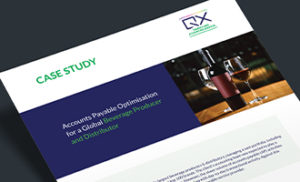

Accounts Payable Outsourcing Services
Build a future-ready accounts payable function with our accounts payable services. Reduce costs by 40-60%—Get in touch today!
Discovery CallAccess specialist talent, optimise process and leverage intelligent automation with QX’s Accounts Payable and T&E Services
Your accounts payable and T&E processes have a huge impact on your cash flow, regulatory compliances and supplier relationships. Reliance on siloed teams, legacy processes and outdated software often stop businesses from building future-proof, high-performance AP teams.
How QX’s accounts payable outsourcing services can transform your operations:
- Significant cost savings: Clients typically see 40-60% reduction in the cost of the AP operations. Additionally, our teams excel at making right-in-time payments to maximise supplier rebates while optimising your working capital.
- Faster and more accurate AP: Our teams leverage your existing systems and QX’s property tools like ProAP to deliver 30-40% efficiency gains while maintaining over 99% accuracy in invoice processing.
- 100% Compliance: We adhere strictly to GAAP, UK accounting standards & best practices, and client-specific processes, reducing risks and ensuring every transaction is accurately processed.
For Business Enquiries
Partner with QX: Your Trusted Leader in Outsourced AP Solutions

Turn to QX Global Group as your go-to partner to modernise and streamline your payment processes. Our approach includes:
- Seamless Tech Integration: Our proprietary tools—QX ProAP, QX SpendChex & QXProcurely—integrate with SAP, Oracle, Dynamics, and more, optimising efficiency across your systems.
- Flexible Scalability: Easily adjust your AP team to meet changing business needs with our adaptable models. We grow with your business.
- UK Accounting Expertise: With 20+ years of experience, we deliver accurate, compliant processes aligned with UK standards.
THE QX ADVANTAGE: AP SOLUTIONS YOU CAN RELY ON
Finance leaders today are tasked with more than managing numbers—they’re expected to drive efficiency, ensure compliance, and foster growth within the organisation. Outsourcing accounts payable operations isn’t just about streamlining processes—it’s about taking a strategic leap toward financial agility and sharper governance.
QX Global Group stands out as a trusted accounts payable outsourcing services provider in the UK, offering tailored, tech-enabled solutions designed to optimise your AP processes. With deep-domain expertise and a partnership-focused approach, we align seamlessly with your business goals to deliver measurable results.
Here’s how QX turns challenges into opportunities and sets itself apart as your go-to outsourced AP solutions partner.

Actionable Insights
With Power BI dashboards and custom reporting, we provide real-time visibility into your AP metrics. From standard KPIs to tailored insights, we empower finance leaders to make informed, strategic decisions.

End-to-End AP Solutions
From invoice capture and validation to reconciliation and reporting, we handle every step of your accounts payable process. With QX, you get a seamless, fully managed AP function tailored to your business needs.

Deep Domain Expertise
Whether you operate in real estate, recruitment, senior living, hospitality, manufacturing, CPG & retail or another sector, our solutions are customised to meet your industry’s unique demands.

Tailored SLAs and KPIs
We work closely with you to define service-level agreements and track key performance indicators that matter most to your business. This ensures transparency, accountability, and alignment with your strategic goals.

Custom Insights and Reporting
Get actionable insights into your AP and T&E operations with tailored reports and intuitive dashboards. As your accounts payable outsourcing services provider, we empower finance leaders to make data-driven decisions and stay ahead of industry trends.

Faster Turnaround Times
Delays in invoice processing or query resolution can disrupt cash flow and operations. As a trusted accounts payable outsourcing company, we reengineer processes and leverage automation tools to significantly reduce response times, ensuring financial stability and operational efficiency.
Our Services

Account Payable
- Supplier direct debit set-up and maintenance
- Supplier invoice posting in line with financial policies and checks
- Maintain the supplier ledger and records
- Document management with in-house customised DMS
- Maintain details of authorised and disputed invoices
- Supplier statement reconciliation
- Effective quality check at bottlenecks/failure modes in every process
- Supplier payment run: Ad hoc/weekly/monthly runs, including international payments
- Supplier helpdesk: Dealing with chasers, supplier queries and escalating issues
Travel & Expense
- New employee onboarding
- Administer purchasing cards (P-cards)
- Weekly/monthly metrics based on expenses type/exception/approval analysis for better insights

AUTOMATION-DRIVEN ACCOUNTS PAYABLE PROCESS
Finance leaders face the constant challenge of driving efficiency, ensuring accuracy, and scaling operations seamlessly. Traditional accounts payable processes often create hurdles—manual workflows delay payments, errors erode supplier trust, and rising transaction volumes strain resources. Fragmented systems and missed cash flow opportunities further hinder growth.
We integrate proprietary technologies, optimized processes, and your existing systems to empower clients to overcome these challenges.
- Streamline Processes: Automate tasks, reduce errors, and focus on high-value financial priorities.
- Build Real-Time Visibility: Access accurate data for better transparency, decisions, and governance.
- Continuous Innovation: Keep honing processes and systems, without any disruption.













FAQs
Here are some of the most frequently asked questions around accounts payable outsourcing services. If you have a question that isn’t answered here, please feel free to contact our sales team – they’ll be happy to help!
When you outsource your accounts payable, you’re handing over the reins of your invoice management and payments to experts. This move is designed to not only simplify your operations but also cut costs and boost efficiency.
Outsourcing includes everything from handling invoices to managing payments and staying compliant with financial laws. It’s also about leveraging the latest technology and gaining expert insights, which can help you improve cash flow, maintain great relationships with suppliers, and enhance overall financial management.
Managing accounts payable in-house can be time-consuming, error-prone, and expensive. Outsourcing your AP processes is a smarter way to streamline operations and focus on what truly matters—growing your business. Here’s why it makes sense:
- Say Goodbye to Inefficiencies: Manual processes slow things down. With accounts payable outsourcing services, you can automate workflows, reduce errors, and speed up invoice processing.
- Gain Financial Flexibility: Better cash flow management means more room to invest in your business. Outsourced AP solutions help optimise payment cycles and free up capital.
- Build Stronger Supplier Relationships: Timely and accurate payments build trust with suppliers, giving you access to better terms and discounts.
- Focus on Strategy: Let your team work on high-value tasks while accounts payable outsourcing companies handle the day-to-day operations seamlessly.
- Access Advanced Tools: Partnering with an accounts payable outsourcing services provider means gaining access to the latest technologies for better visibility, compliance, and scalability.
Accounts payable services streamline your financial operations by taking care of everything from managing incoming invoices to ensuring suppliers are paid on time. The process includes verifying invoices against purchase orders, securing approvals, making payments, and keeping detailed records for audits.
By outsourcing these tasks, you may also get access to specialised software that automates and enhances the accuracy and efficiency of these operations – or the provider could optimise the use of your existing software. This not only keeps you compliant with financial laws but also bolsters your relationships with suppliers and sharpens your overall financial management.
Not at all. Outsourcing accounts payable doesn’t take control away—it enhances your ability to manage the process more effectively. Here’s how businesses maintain control with accounts payable outsourcing services:
- Dedicated teams: You are not hiring services, you are setting up a team of your choice, working only for you, following your rules and instructions.
- Clear Visibility: With access to real-time dashboards and custom reports, businesses can stay on top of their accounts payable operations at all times.
- Tailored Processes: Outsourced AP solutions are designed to match your workflows, ensuring that all processes follow your company’s policies and preferences.
- Control Over Key Decisions: While routine tasks are handled externally, approvals and important decisions remain firmly in your hands.
- Reduced Risks: Accounts payable processing services improve accuracy and compliance, allowing businesses to focus on oversight without worrying about errors.
Managing accounts payable can be complex, with delays, errors, and high costs often slowing businesses down. Accounts payable outsourcing services offer a smarter way to overcome these challenges and create a more efficient process. Here’s how outsourcing can help:
- Faster Payment Cycles: Outsourced AP solutions use automation to process invoices quickly, reducing delays and ensuring suppliers are paid on time.
- Fewer Errors: Manual data entry is one of the biggest culprits of inaccuracies. Accounts payable processing services minimise these mistakes with advanced tools and standardised workflows.
- Lower Costs: Outsourcing reduces the need for large in-house teams and leverages cost-effective systems to manage your AP function efficiently.
- Stronger Compliance: With automated checks and audit-ready records, accounts payable outsourcing services help businesses stay compliant with financial regulations.
- Better Visibility: Real-time dashboards and tailored reporting give you clear insights into your AP operations, empowering better financial decisions.
Outsourcing your accounts payable can seriously simplify things, making sure your bills are paid faster, with fewer mistakes, and at a lower cost. Here’s a breakdown of the benefits:
- Speed up payments: By using automated systems, outsourcing can cut down on those annoying payment delays, ensuring your suppliers get their money on time.
- Cut down on errors: Say goodbye to the headaches caused by manual data entry. Outsourced services use top-notch tools and streamlined processes to keep mistakes to a minimum.
- Reduce costs: No need to keep a big in-house AP team—outsourcing taps into cost-effective methods to handle your payments smoothly.
- Stay compliant: Automated systems help you stick to financial rules by keeping everything tidy and audit-ready.
- Get a clearer picture: With modern reporting tools, you get real-time updates and insights into your AP processes, helping you make smarter financial decisions.
Choosing QX Finance & Accounting for your outsourced accounts payable services can really level up your financial operations. Here’s what sets us apart:
- Proven Expertise: We’ve been at this for years and know the ins and outs of AP services. We understand different industry needs and deliver solutions that work seamlessly.
- Customised Solutions: At QX, we don’t believe in one-size-fits-all. We tailor our AP services to fit perfectly with your current systems and workflows.
- Tech-Driven Efficiency: We use the latest technology and automation to speed things up, cut down on errors, and make your AP processes smoother.
- Significant Cost Savings: Working with us, companies typically cut their operational costs by 40-60% while still maintaining top-notch accuracy and efficiency.
- Scalability and Flexibility: Our services are built to grow with you. As your business expands or needs change, our AP solutions adapt effortlessly.



